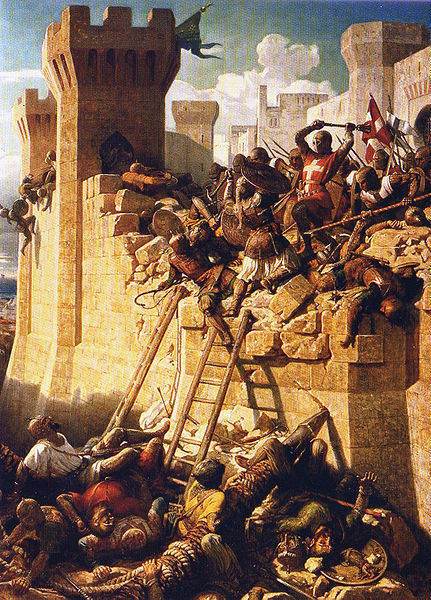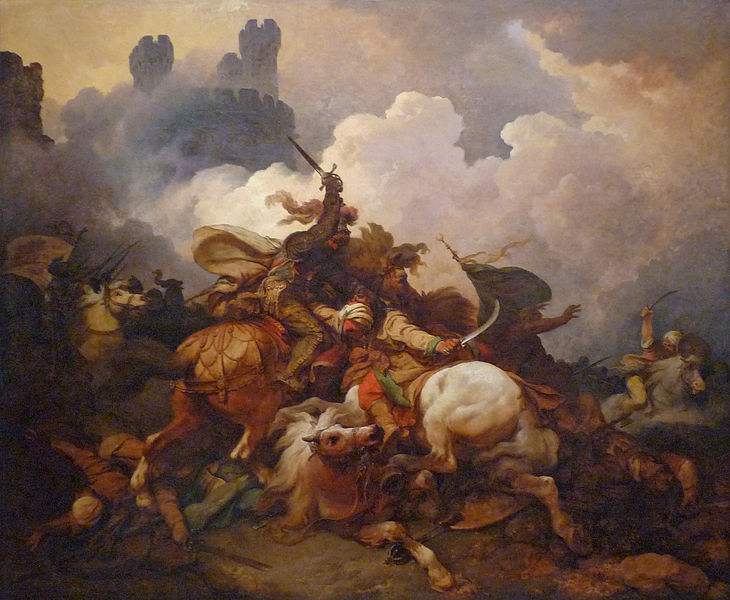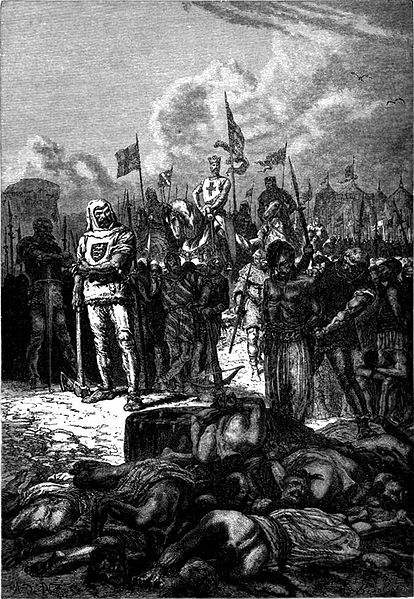II. Foundation of Christian states in the East;
III. First destruction of the Christian states (1144-87);
IV. ATTEMPTS TO RESTORE THE CHRISTIAN STATES AND THE CRUSADE AGAINST SAINT-JEAN D’ACRE
The news of these events caused great consternation in Christendom, and Pope Gregory VIII strove to put a stop to all dissensions among the Christian princes. On 21 January, 1188, Philip Augustus, King of France, and Henry II, Plantagenet, became reconciled at Gisors and took the cross. On 27 March, at the Diet of Mainz, Frederick Barbarossa and a great number of German knights made a vow to defend the Christian cause in Palestine. In Italy, Pisa made peace with Genoa, Venice with the King of Hungary, and William of Sicily with the Byzantine Empire. Moreover, a Scandinavian fleet consisting of 12,000 warriors sailed around the shores of Europe, when passing Portugal, it helped to capture Alvor from the Mohammedans.

The Hospitaller grand master Guillaume de Clermont defending the walls at the Siege of Acre in 1291, by Dominique-Louis Papéty.
Enthusiasm for the crusade was again wrought up to a high pitch; but, on the other hand, diplomacy and royal and princely schemes became increasingly important in its organization. Frederick Barbarossa entered into negotiations with Isaac Angelus, Emperor of Constantinople, with the Sultan of Iconium, and even with Saladin himself. It was, moreover, the first time that all the Mohammedan forces were united under a single leader; Saladin, while the holy war was being preached, organized against the Christians something like a counter-crusade. Frederick Barbarossa, who was first ready for the enterprise, and to whom chroniclers attribute an army of 100,000 men, left Ratisbon, 11 May, 1189. After crossing Hungary he took the Balkan passes by assault and tried to outflank the hostile movements of Isaac Angelus by attacking Constantinople. Finally, after the sack of Adrianople, Isaac Angelus surrendered, and between 21 and 30 March, 1190, the Germans succeeded in crossing the Strait of Gallipoli. As usual, the march across Asia Minor was most arduous. With a view to replenishing provisions, the army took Iconium by assault. On their arrival in the Taurus region, Frederick Barbarossa tried to cross the Selef (Kalykadnos) on horseback and was drowned. Thereupon many German princes returned to Europe; the others, under the emperor’s son, Frederick of Swabia, reached Antioch and proceeded thence to Saint-Jean d’Acre.

The Hospitalians’ Fortress in Acre, Palestine. Inside is a 350m long tunnel 350m long, was constructed by the Knights Templar to serve as a strategic underground passageway linking the fortress with the port.
It was before this city that finally all the crusading troops assembled. In June, 1189, King Guy de Lusignan, who had been released from captivity, appeared there with the remnant of the Christian army, and, in September of the same year, the Scandinavian fleet arrived, followed by the English and Flemish fleets, commanded respectively by the Archbishop of Canterbury and Jacques d’Avesnes. This heroic siege lasted two years. In the spring of each year reinforcements arrived from the West, and a veritable Christian city sprang up outside the walls of Acre. But the winters were disastrous to the crusaders, whose ranks were decimated by disease brought on by the inclemency of the rainy season and lack of food. Saladin came to the assistance of the city, and communicated with it by means of carrier pigeons. Missile-hurtling machines (pierrières), worked by powerful machinery, were used by the crusaders to demolish the walls of Acre, but the Mohammedans also had strong artillery. This famous siege had already lasted two years when Philip Augustus, King of France, and Richard Coeur de Lion, King of England, arrived on the scene. After long deliberation they had left Vézelay together, 4 July, 1190. Richard embarked at Marseilles, Philip at Genoa, and they met at Messina. During a sojourn in this place, lasting until March, 1191, they almost quarrelled, but finally concluded a treaty of peace. While Philip was landing at Acre, Richard was shipwrecked on the coast of Cyprus, then independent under Isaac Comnenus. With the aid of Guy de Lusignan, Richard conquered this island.

Painting by Philip Jacques de Loutherbourg of the Battle between King Richard I Lionheart and Saladin at Saint-Jean d’Acre.
The arrival of the Kings of France and England before Acre brought about the capitulation of the city, 13 July 1191. Soon, however, the quarrel of the French and English kings broke out again, and Philip Augustus left Palestine, 28 July. Richard was now leader of the crusade, and, to punish Saladin for the non-fulfilment of the treaty conditions within the time specified, had the Mohammedan hostages put to death. Next, an attack on Jerusalem was meditated, but, after beguiling the Christians by negotiations, Saladin brought numerous troops from Egypt. The enterprise failed, and Richard compensated himself for these reverses by brilliant but useless exploits which made his name legendary among the Mohammedans. Before his departure he sold the Island of Cyprus, first to the Templars, who were unable to settle there, and then to Guy de Lusignan, who renounced the Kingdom of Jerusalem in favour of Conrad of Montferrat (1192). After a last expedition to defend Jaffa against Saladin, Richard declared a truce and embarked for Europe, 9 October, 1192, but did not reach his English realm until he had undergone a humiliating captivity at the hands of the Duke of Austria, who avenged in this way the insults offered him before Saint-Jean d’Acre.
While Capetians and Plantagenets, oblivious of the Holy War, were settling at home their territorial disputes, Emperor Henry VI, son of Barbarossa, took in hand the supreme direction of Christian politics in the East. Crowned King of the Two Sicilies, 25 December, 1194, he took the cross at Bari, 31 May, 1195, and made ready an expedition which, he thought, would recover Jerusalem and wrest Constantinople from the usurper Alexius III. Eager to exercise his imperial authority he made Amaury de Lusignan King of Cyprus and Leo II King of Armenia. In September, 1197, the German crusaders started for the East. They landed at Saint-Jean d’Acre and marched on Jerusalem, but were detained before the little town of Tibnin from November, 1197, to February 1198. On raising the siege, they learned that Henry VI had died, 28 September, at Messina, where he had gathered the fleet that was to convey him to Constantinople. The Germans signed a truce with the Saracens, but their future influence in Palestine was assured by the creation of the Order of the Teutonic Knights. In 1143, a German pilgrim had founded a hospital for his fellow-countrymen; the religious who served it moved to Acre and, in 1198, were organized in imitation of the plan of the Hospitallers, their rule being approved by Innocent III in 1199.
LOUIS BRÉHIER (Catholic Encyclopedia)











